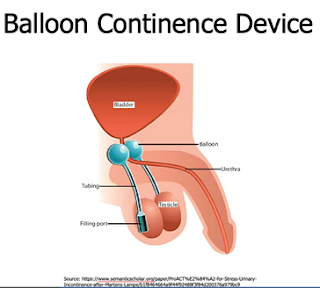This month, “Spotlight on CPT” presents information on CPT coding for a balloon continence device. As intimated by its name, a balloon continence device is used for patients who are experiencing urinary incontinence. Urinary incontinence can be a result of an infection, obstruction, neurological disorder, childbirth, menopause, and prostate issues like enlargement or cancer. The incontinence can occur with simple daily activities such as sneezing, coughing, or even physical activity. This periurethral device can be used in treatment for men who have undergone prostate resection or removal. Two balloons are placed on either side of the urethra at the level of the bladder neck with the fluid inside the balloons providing pressure and support of the bladder neck reducing the incidence of urinary leakage.
As you can see in the picture below, the balloons are connected to a port via tubing. This allows the physician to make adjustments to the device if necessary.
The CPT codes for periurethral transperineal adjustable balloon continence device became effective on January 1, 2022. There is a code for the initial bilateral insertion of the device at 53451, as well a code for a unilateral insertion, if necessary, at 53452. Of course, there is a code for the balloon removal at 53453, and coding professionals would do well to note that this code can be assigned twice if two balloons are removed as the code is for EACH balloon. The final code (53454) is for any fluid volume adjusting that is required, and may only be assigned once per encounter.
53451 Periurethral transperineal adjustable balloon continence device; bilateral insertion, including
cystourethroscopy and imaging guidance
53452 unilateral insertion, including cystourethroscopy and imaging guidance
53453 removal, each balloon
53454 percutaneous adjustment of balloon(s) fluid volume
Now, light has been shed on coding procedures for balloon continence devices.
About the Author
 Dianna Foley, RHIA, CHPS, CCS, CDIP is
OHIMA's Coding Education Coordinator. Dianna has been an HIM
professional for 20 years. She progressed through the ranks of coder,
department supervisor, and department director, to her current role as a
coding consultant.
Dianna Foley, RHIA, CHPS, CCS, CDIP is
OHIMA's Coding Education Coordinator. Dianna has been an HIM
professional for 20 years. She progressed through the ranks of coder,
department supervisor, and department director, to her current role as a
coding consultant. She recently served as the program director for Medical Coding and HIT at Eastern Gateway Community College. Dianna earned her bachelor's degree from the University of Cincinnati subsequently achieving her RHIA, CHPS, and CCS certifications. She is an AHIMA Approved ICD-10-CM/PCS Trainer and a a presenter at regional HIM meetings and the OHIMA Annual Meeting.


